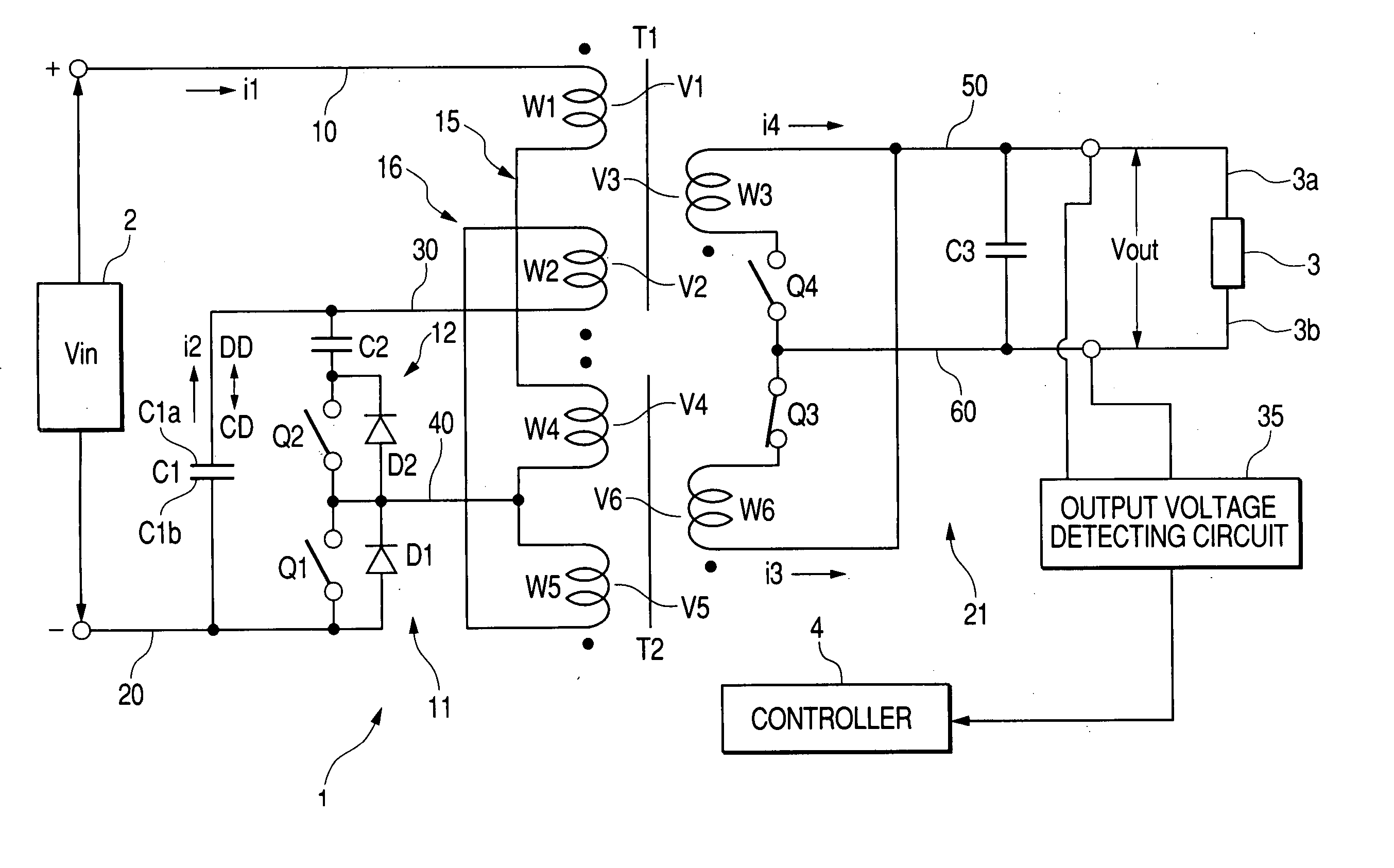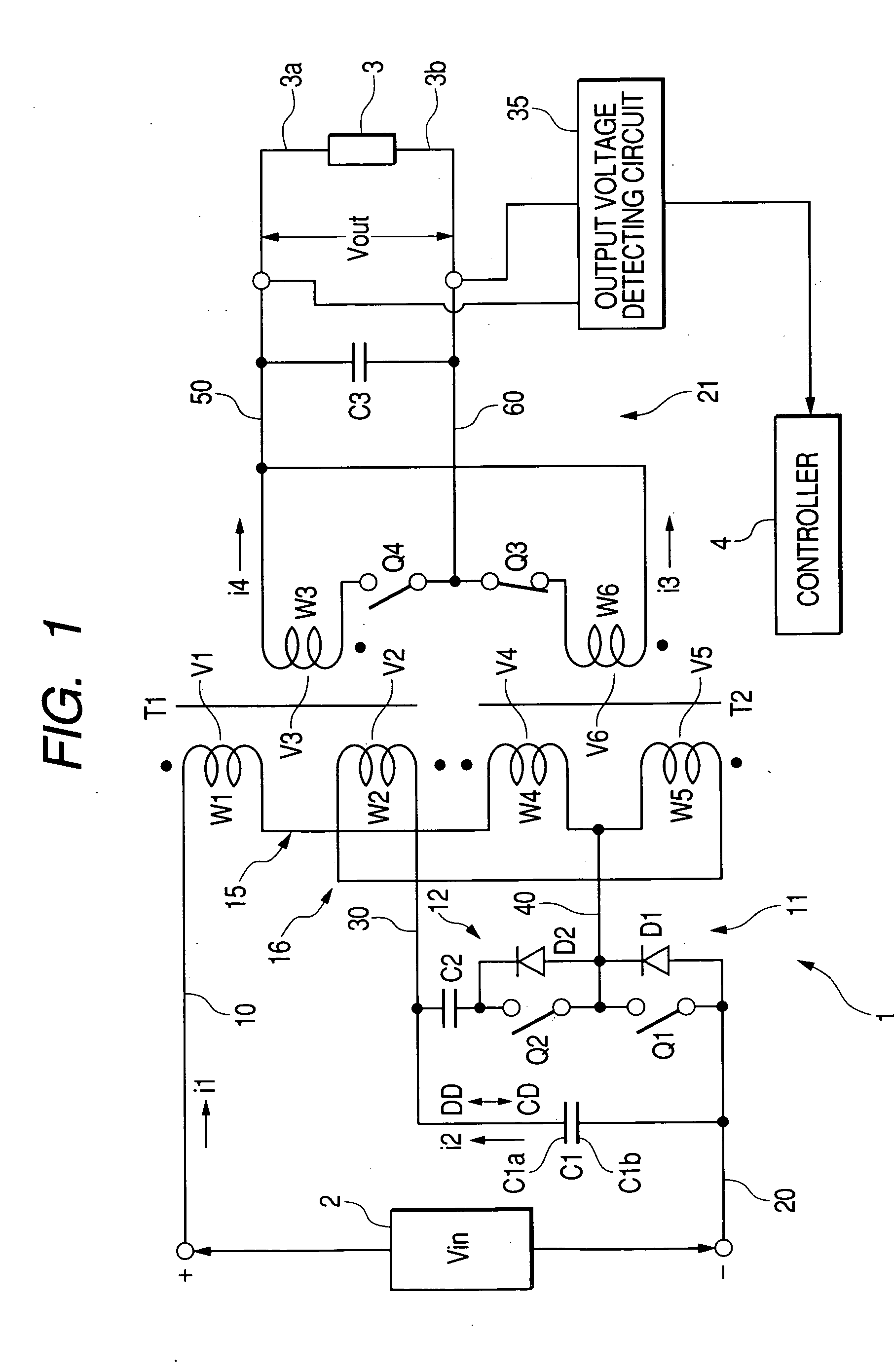DC-DC converter
a dc-dc converter and converter technology, applied in the direction of electric variable regulation, process and machine control, instruments, etc., can solve the problems of increasing the cost large size of capacitors cb>101/b>, and the upsizing of dc to dc voltage converter systems, so as to reduce the amount of ripple components contained
- Summary
- Abstract
- Description
- Claims
- Application Information
AI Technical Summary
Benefits of technology
Problems solved by technology
Method used
Image
Examples
first embodiment
[0070] [First Embodiment]
[0071] (Whole Structure of a DC to DC Converter)
[0072] The whole structure of a DC to DC converter according to a first embodiment will be explained in accordance with FIG. 1.
[0073] The DC to DC converter 1 is served as a unidirectional step down converter, the input side of which is coupled to a high-voltage input DC power supply 2, as a first voltage system. The output side of the DC to DC converter 1 is coupled to a low-voltage load 3, as a second voltage system.
[0074] As the DC to DC converter 1, a unidirectional step up converter may be used, and as the low-voltage load 3, a low-voltage power supply for supplying a DC voltage lower than the high DC voltage may be used.
[0075] The DC to DC converter 1 includes a first transformer assembly T1, a second transformer assembly T2, and a first converting circuit 11. The first converting circuit 11 includes a first switching element Q1, a first capacitor C1, and a clamp circuit 12. The clamp circuit 12 consi...
second embodiment
[0205] [Second Embodiment]
[0206] A DC to DC converter according to a second embodiment of the present invention will be described in accordance with FIG. 10. In the second embodiment, the controller 4 of the DC to DC converter controls the on duty ratio of the first switching element Q1 within a predetermined range X centered at 50 percents, such as 40 to 60 percents. The DC to DC converter is used for applications which does not require a wide range of the on duty ratio.
[0207] This structure of the DC to DC converter according to the second embodiment allows the ripple components contained in the output current io (i3+i4) to be reduced less than a predetermined percents, such as 10 percents (see FIG. 10). The ratio (percents) of the ripple components contained in the output current io have a characteristic that continuously varies depending on the on duty ratio of the first switching element Q1 (see FIG. 10). The predetermined value of the on duty ratio corresponding to the minimu...
third embodiment
[0209] [Third Embodiment]
[0210] A DC to DC converter according to a third embodiment of the present invention will be described in accordance with FIG. 11. In the third embodiment, the DC to DC converter 1B is served as a bidirectional DC to DC converter.
[0211] That is, the DC to DC converter 1B has a primary circuit (PC) 300 for the transformer assemblies T1 and T2, which corresponds to the circuit composed of the capacitors C1, C2, the switching elements Q1, Q2, and the connections thereamong, the transformer assemblies T1 and T2, and the input DC power supply 2. The DC to DC converter 1B also has a synchronous rectifying circuit (SC) 400, which corresponds to the circuit composed of the switching elements Q3, Q4, the capacitor C3, and the connections thereamong, the transformer assemblies T1 and T2, and the load, such as a power supply 3.
[0212] The DC to DC converter 1B has a controller 500 corresponding to the controller 4 shown in FIG. 1, and a driver 600 connected between ea...
PUM
 Login to View More
Login to View More Abstract
Description
Claims
Application Information
 Login to View More
Login to View More - R&D
- Intellectual Property
- Life Sciences
- Materials
- Tech Scout
- Unparalleled Data Quality
- Higher Quality Content
- 60% Fewer Hallucinations
Browse by: Latest US Patents, China's latest patents, Technical Efficacy Thesaurus, Application Domain, Technology Topic, Popular Technical Reports.
© 2025 PatSnap. All rights reserved.Legal|Privacy policy|Modern Slavery Act Transparency Statement|Sitemap|About US| Contact US: help@patsnap.com



